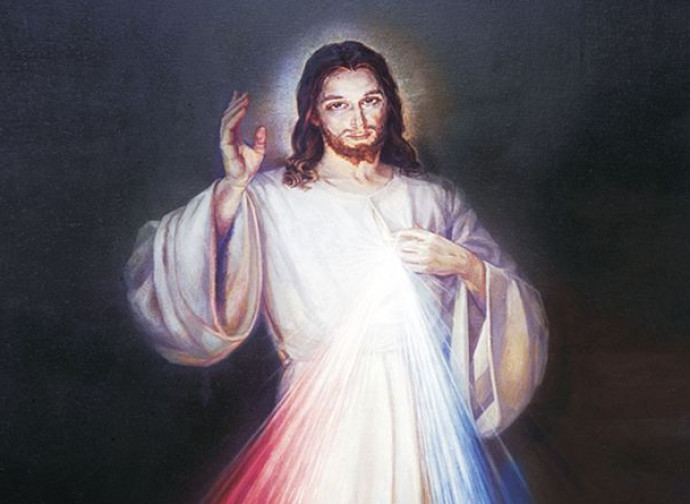Divine Mercy Sunday
On 22 February 1931 Jesus first communicated to St. Faustina Kowalska His desire for a Feast of Divine Mercy to be celebrated on the first Sunday after Easter, asking her to announce the extraordinary graces He would bestow.

On 22 February 1931 Jesus first communicated to St. Faustina Kowalska His desire for a Feast of Divine Mercy to be celebrated on the first Sunday after Easter, asking her to announce the extraordinary graces He would bestow. He appeared to her in a white robe with his right hand blessing and his left hand resting on his chest, from which two large rays poured out, one red and the other pale. He ordered her to paint an image depicting what she saw and bearing the inscription: “Jesus I trust in You”. On that same occasion Our Lord made her a solemn promise, valid for every pilgrim soul on earth: “I promise that the soul that will venerate this image will not perish. I also promise already on this earth, but especially at the hour of death, victory over enemies. I myself will defend it as My own glory”.
Through the revelations to Sister Faustina, Jesus asked priests to announce “My great Mercy for the souls of sinners,” asking every person to invoke His forgiveness with confidence. After 22 February 1931, as proof of how important the Feast of Divine Mercy is in His plan for salvation, he reminded the saint of His request in 14 other apparitions, each time giving new elements on how to celebrate it and why. The choice of the first Sunday after Easter indicates precisely the intimate link between the mystery of the Redemption and this feast, a link that is made even more evident by its novena (“during this novena I will bestow all kinds of graces”, said the Lord), which begins on Good Friday. In fact, Jesus explained that “souls perish, despite My sorrowful Passion”, through the refusal of divine Love. And with the Feast of Divine Mercy He wanted to offer another great possibility of salvation, before His just judgment.
Jesus promised special graces to those who worthily receive the Eucharist on Divine Mercy Sunday: “The soul that approaches confession and Holy Communion receives total remission of sins and punishments”. And he added: “On that day all the floodgates through which My divine graces flow are open”. These exceptional gifts are, according to Father Ignatius Rozycki (a theologian very dear to Saint John Paul II), even greater than the plenary indulgence (which is specifically the remission of the temporal penalty for sins, which are already forgiven) and could be equated with a “second Baptism”. Confession can also be made a few days earlier. There remains the need to receive Communion in a state of grace (without any mortal sin), and to worship fervently the Divine Mercy, defined by Jesus as “the greatest attribute of God”.
Among those who most helped Sister Faustina to spread devotion to the Divine Mercy is Blessed Michael Sopocko (1888-1975), her spiritual director: “He will help you to do My will on earth”, God told her through an interior locution. It was he who asked Eugeniusz Kazimirowski in 1934 to paint the first image of the Merciful Jesus. The painter executed the painting under the strict supervision of the saint. And Father Sopocko exhibited it for the first time in the Gate of Dawn church in Vilnius from April 26 to April 28, 1935, the latter day coinciding with the first Sunday after Easter and during which a solemn Mass was celebrated.
With regard to the image painted by Kazimirowski there is one memorable incident: Saint Faustina was so saddened by the impossibility of depicting Jesus in all His beauty that one day, while work was still in progress, she burst into tears in the chapel: “Who can paint You beautiful as you are?”, she said to the Lord, hearing these words in reply: “Not in the beauty of the colours nor of the brush is the greatness of this image, but in My grace”. Another time Jesus revealed to her: “My gaze from this image is the same as My gaze from the cross”.
In 1943, five years after Sister Faustina's birth into Heaven, another painter, Adolf Hyla, went to the saint's sisters in Krakow, offering to paint a picture to thank God for having saved his family from the war. Thus was born the version of the painting of the Merciful Jesus best known today, providentially spread through millions of holy cards all over the world. In the meantime, Kazimirowski's original painting was preserved thanks to the work of some of the faithful, who in the dark years of the communist dictatorship managed to prevent – at times in the most daring of ways – its destruction. In spite of various obstacles, the Feast of Divine Mercy became increasingly widespread, until it was finally established in 2000 by St. John Paul II.
Read more:
Diary of St. Maria Faustina Kowalska




